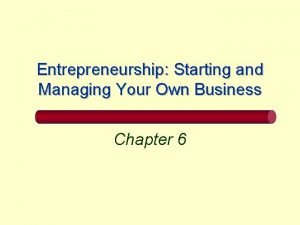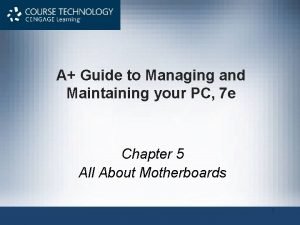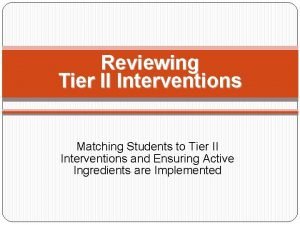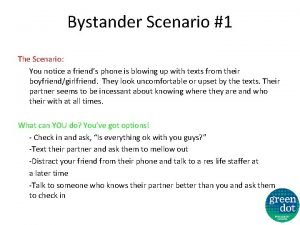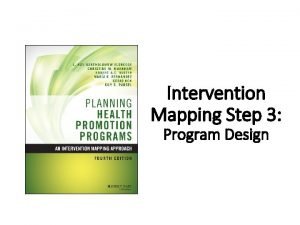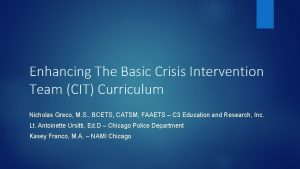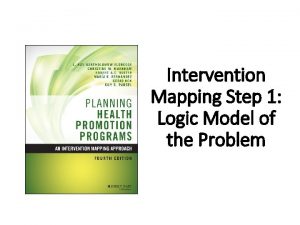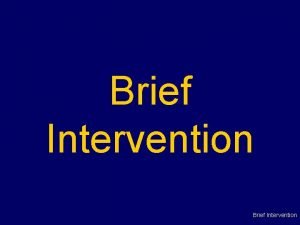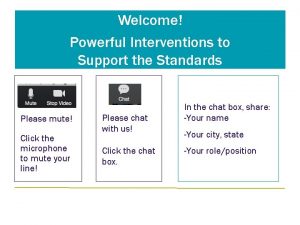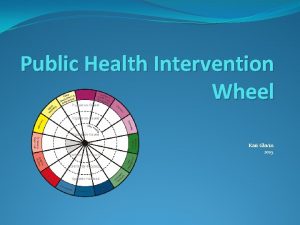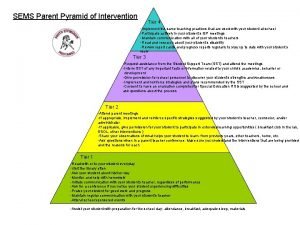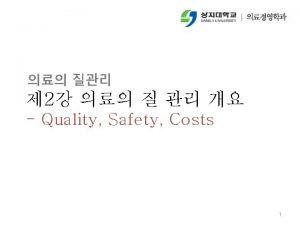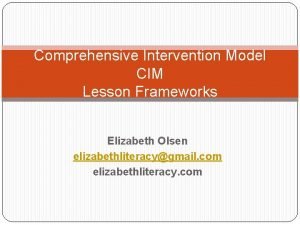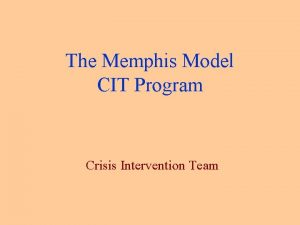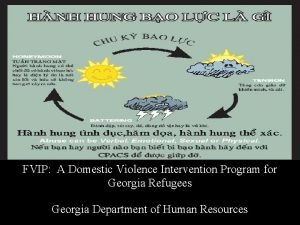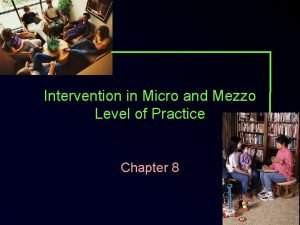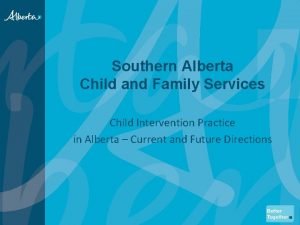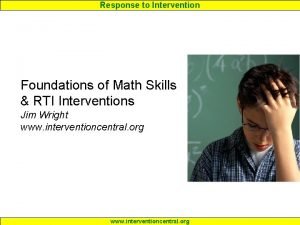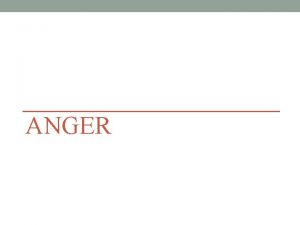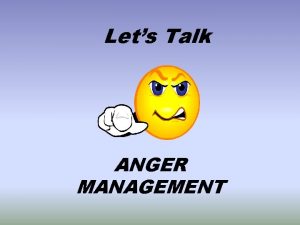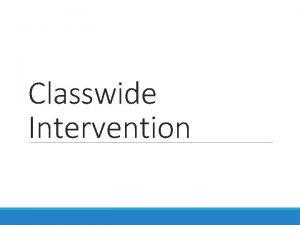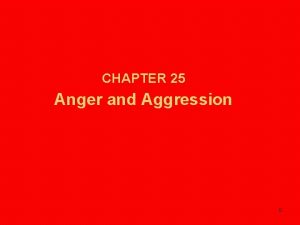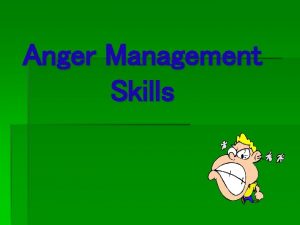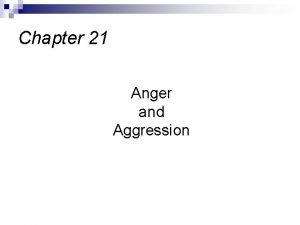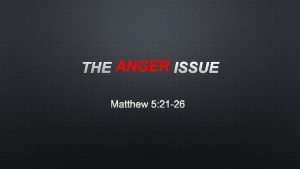Anger Intervention A Guide to Managing Anger in












































- Slides: 44

Anger Intervention A Guide to Managing Anger in the Classroom Charles D. York, MS ISS-Autism Consultant Do. DDS-Europe

Anger Facts Follows a predictable pattern of levels have observable characteristics Opportunities for intervention are present at every level May be about something other than the situation at hand (lack of sleep, peer relationship problems, fight with parents, etc. )

The Anger Cycle: Levels Overview 5. Outburst 4. Challenge 3. Refusal 2. Back Talk 1. Questions 7. In Control 6. Quiet Period

The Anger Cycle: Level 1: Questions 5. Outburst 4. Challenge 3. Refusal 2. Back Talk 1. Questions 7. In Control 6. Quiet Period

The Anger Cycle: Level 1: Questions Description – May be legitimate questions about an activity, missed information, etc. • “What are we suppose to be doing now? ” • “Why do I have to go? ” • “How does learning this stuff help me? ” – May be an attempt to question your authority • “Why do I have to listen to you? ” • “Who died and made you boss? ”

The Anger Cycle: Level 1: Questions The easiest way to prevent escalation from this point is simply to answer the question Assume that questions are real. Do not assume the student is trying to “start something” or be manipulative by asking questions Use “Reflective Listening” to maintain clear communication

The Anger Cycle: Level 1: Questions Reflective listening – Let the student do the talking – Focus on what the student is saying – Focus on the student’s emotions (look at body language, sound of voice, etc. ) – Restate what the student is saying to you to show you understand – Keep your answers short and clear

The Anger Cycle: Level 1: Questions An Example: The Wrong Way Billy: “Why do I have to go to the gym? ” Staff: “Billy, get in line. ” Billy: “But why? Why can’t I stay here? ” Staff: “Billy, I’m not putting up with this today. Get in line. ” Billy: “You’re not the boss of me!” Situation escalates to “Back Talk”

The Anger Cycle: Level 1: Questions An Example: The Right Way Billy: “Why do I have to go to the gym? ” Staff: “Because the class is going to the gym. Is there a reason why you do not want to go? ” Billy: “I have a headache and the gym is really loud. ” Staff: “You have a headache. I can understand why you don’t want to go. I will ask Ms Johnson if you can stay in her

The Anger Cycle: Level 2: Back Talk 5. Outburst 4. Challenge 3. Refusal 2. Back Talk 1. Questions 7. In Control 6. Quiet Period

The Anger Cycle: Level 2: Back Talk Description – Student is showing his anger and trying to incite you to be angry • “You’re always telling me what to do! Why don’t you do it? ” • “You don’t know this stuff either. How can you teach me? ” • “You’re not a real teacher. ” • “This is all just stupid. ”

The Anger Cycle: Level 2: Back Talk Stay calm and in control Be aware of your facial expressions, your posture, and how your voice sounds – Keep a distance of at least 3 feet between you and the student – Speak slowly and be friendly – Do not cross your arms or make yourself look “closed” Redirect the student to the topic of the

The Anger Cycle: Level 2: Back Talk An Example: The Wrong Way Billy: “You’re not the boss of me!” Staff: (moves in close, arms crossed, looking mean) “That’s enough! Get in line right now or you get detention. ” Billy: (Crosses his arms and throws himself in his desk seat) “No. I’m not going” Situation escalates to “Refusal”

The Anger Cycle: Level 2: Back Talk An Example: The Right Way Billy: “You’re not the boss of me!” Staff: (Steps away from Billy and lowers arms to the side. Takes a breath, thinks about body language, and uses a calm voice) “I can see you’re upset, but we’re talking about the gym. Can you tell me why you don’t want to go? ”

The Anger Cycle Level 3: Refusal 5. Outburst 4. Challenge 3. Refusal 2. Back Talk 1. Questions 7. In Control 6. Quiet Period

Description – The student is challenging your control of the situation by refusing to comply with a direction • • “I’m not going. ” “I’m not going to do that. ” Crossing arms, turning head, ignoring you “Do it yourself. ”

The Anger Cycle Level 3: Refusal Stay calm, cool and collected. Your behavior impacts the situation. If you are responding to the student’s anger, the student will become more angry Give the student two clear choices that are reasonable and appropriate. Explain the consequences for each of the choices

The Anger Cycle Level 3: Refusal An Example: The Wrong Way Billy: “No. I’m not going. ” Staff: (Shaking finger in Billy’s face) “You better get out of that chair or you’re going to the principal’s office and I’m calling your parents. ” Billy: (Staring staff in the eye)“Make me. ” Situation escalates to “Challenge”

The Anger Cycle Level 3: Refusal An Example: The Right Way Billy: “No, I’m not going!” Staff: “Billy, you have a choice. You can come with us to the gym, or you can wait for us in Ms Johnson’s room. But if you go to Ms Johnson’s room, then you need to finish your homework. ” Situation resolved

The Anger Cycle Level 4: Challenge 5. Outburst 4. Challenge 3. Refusal 2. Back Talk 1. Questions 7. In Control 6. Quiet Period

The Anger Cycle Level 4: Challenge Description – The student is attempting to directly challenge your authority • “You can’t make me do it!” • “I don’t have to do that!” • “Pick on somebody else!”

The Anger Cycle Level 4: Challenge Try to remove either the student or the audience. The student may escalate faster if the other students are watching Seek help if you think this will escalate further Check your own behavior and make sure you are in control Increase distance between the student and yourself Restate choices

The Anger Cycle Level 4: Challenge An Example: The Wrong Way Billy: “Make me. ” Staff: (Grabs Billy’s arm and attempts to pull him from the chair) “That’s it buddy, you’re outta here! And you won’t be coming back to my class!” Billy: (Becomes irate and starts shouting profanity) Situation escalates to “Outburst”

The Anger Cycle Level 4: Challenge An Example: The Right Way Billy: “Make me. ” Staff: (To class) “Class, line up in the hall. I will be right there. (To Billy) “I need you to choose. Will you come to the gym, or will you go to Ms Johnson’s room. ” Billy: “Fine! I will go to Ms Johnson’s room. ”

The Anger Cycle Level 5: Outburst 5. Outburst 4. Challenge 3. Refusal 2. Back Talk 1. Questions 7. In Control 6. Quiet Period

The Anger Cycle Level 5: Outburst Description – The student is no longer able to maintain control. May take two forms: Verbal or physical • Verbal Outburst- Student screams, yells, shouts profanity, cries, etc. • Physical Outburst- Student attacks, kicks, throws, breaks, runs, etc.

The Anger Cycle Level 5: Outburst If the outburst is verbal: – Keep a space between the student and yourself – Allow the student to vent – Do not attempt communication at this point – Wait for the episode to progress naturally to the next level; the “Quiet Period”

The Anger Cycle Level 5: Outburst If the outburst is physical: – Remove the other students from the room – Exit the room yourself, and attempt to maintain visual contact with the student – If your school has a Crisis Response Team (CRT), call the team and implement Non. Violent Physical Crisis Intervention – If your school does not have a CRT, maintain observation and wait for the student to move into the next level; the “Quiet Period. ”

The Anger Cycle Level 5: Outburst An Example: The Wrong Way Billy: (Becomes irate and starts shouting profanity. Grabs a book off his desk and throws it across the room) Staff: (Grabs Billy’s arm and attempts to subdue him. Staff and student fall over the desk and into the student seated at the next desk) Situation is chaos and risks injury to

The Anger Cycle Level 4: Challenge NEVER attempt a physical intervention unless you have been trained and approved by Do. DDS in Non. Violent Crisis Intervention

The Anger Cycle Level 5: Outburst An Example: The Right Way Billy: (Becomes irate and starts shouting profanity. Grabs a book off his desk and throws it across the room) Staff: (Students are already in the hall, staff member moves far away from Billy and exits the room. Holding the door open, staff observes. Sends one student to the classroom next door to get the teacher, another student to the office)

The Anger Cycle Level 6: Quiet Period 5. Outburst 4. Challenge 3. Refusal 2. Back Talk 1. Questions 7. In Control 6. Quiet Period

The Anger Cycle Level 6: Quiet Period Description – After every outburst, the student will reach a “quiet period” in which their emotional status is below their average state – Usually represented by being quiet, lack of energy, sometimes crying, moving to a protected area, etc.

The Anger Cycle Level 6: Quiet Period Give the student space and time to calm down Quietly offer support

The Anger Cycle Level 6: Quiet Period An Example: The Wrong Way The struggle has ended. Billy is exhausted and breathing hard. He is sitting against a wall in the back of the room. Staff: (Shouting) “Are you happy now? See what you’ve done? ” If anything is broken, you’re paying for it!”

The Anger Cycle Level 6: Quiet Period An Example: The Right Way The room is trashed. Billy has quit throwing things and is standing in the middle of the room. Staff enters, but keeps a large distance between them. Staff: “I can see you’re upset. Why don’t you have a seat and cool off. I’m going to sit at my desk and grade some papers. ”

The Anger Cycle Level 7: In Control 5. Outburst 4. Challenge 3. Refusal 2. Back Talk 1. Questions 7. In Control 6. Quiet Period

The Anger Cycle Level 7: In Control Description – The outburst is over, and the student has regained control – Still a sensitive time, and care should be given not to re-escalate the situation

The Anger Cycle Level 7: In Control Invite the student to rejoin the class Ask the student to clean up any messes or damage caused Ask the student which of the choices they have selected

The Anger Cycle Level 7: In Control An Example: The Wrong Way (The principal has entered the room. Students are still quiet from the shock) Staff: (To principal)“Mr. Smith, look what he’s done this time. He could have hurt the other students! I want him suspended. ” (To Billy) “You better get up here and start cleaning up this mess!” Staff creates a hostile environment. Billy remains angry and non-compliant.

The Anger Cycle Level 7: In Control An Example: The Right Way Staff: “You seem pretty calm now. Let me give you a hand we will clean up this mess. You were really upset. When you’re ready, I’d like to talk about what happened. ” Student repairs damage, an opportunity for discussion is opened, and the student is made aware that the behavior has not impacted his

Review Anger follows a predictable and observable pattern There appropriate interventions for each level of the anger cycle You are an active participant in the cycle, and can escalate or de-escalate the behavior with your actions

Review When a student reaches the outburst level, they are no longer in control of their actions The key point during an outburst is to create the safest environment possible to prevent injury NEVER attempt a physical intervention unless you have received training from Do. DDS in NVCI

The End Chuck York ISS-Autism Consultant Do. DDS-Europe DSN: 338 -7759 Comm: 0611 -380 -7759 E-mail: chuck. york@eu. dodea. edu
 Knp intervention guide
Knp intervention guide Find the measures of the numbered angles in rhombus defg
Find the measures of the numbered angles in rhombus defg 11-1 areas of parallelograms and triangles answer key
11-1 areas of parallelograms and triangles answer key Serve as your guide in managing your enterprise
Serve as your guide in managing your enterprise Guide to managing and maintaining your pc
Guide to managing and maintaining your pc Guide to managing and maintaining your pc
Guide to managing and maintaining your pc Guide to managing and maintaining your pc
Guide to managing and maintaining your pc Class pass intervention
Class pass intervention Intervention mapping stappen
Intervention mapping stappen Student intervention matching form
Student intervention matching form Coarctation de l'aorte
Coarctation de l'aorte Bystander scenarios
Bystander scenarios Serial casting before and after
Serial casting before and after Intervention mapping
Intervention mapping Peer to peer intervention
Peer to peer intervention Basic crisis intervention
Basic crisis intervention Family violence intervention program atlanta
Family violence intervention program atlanta Intervention mapping
Intervention mapping Namides
Namides Lli reading intervention
Lli reading intervention Mike intervention update
Mike intervention update K-trider level 1
K-trider level 1 Prolapsed cord nursing diagnosis
Prolapsed cord nursing diagnosis Logic model of the problem intervention mapping
Logic model of the problem intervention mapping Brief intervention frames
Brief intervention frames Sbirt oregon
Sbirt oregon Sipps levels
Sipps levels Fire and ice symbolic archetype examples
Fire and ice symbolic archetype examples Nursing intervention of vomiting
Nursing intervention of vomiting Etetp
Etetp Strategic intervention techniques in change management
Strategic intervention techniques in change management Innate wisdom vs educated stupidity
Innate wisdom vs educated stupidity V math live
V math live Public health intervention wheel norsk
Public health intervention wheel norsk Tier 4 intervention
Tier 4 intervention Nursing care plan pulmonary embolism
Nursing care plan pulmonary embolism What is positive intervention consent
What is positive intervention consent 권영대
권영대 Comprehensive intervention model
Comprehensive intervention model Early warning intervention and monitoring system
Early warning intervention and monitoring system Memphis cit model
Memphis cit model Fvip georgia
Fvip georgia Micro level intervention
Micro level intervention Southwest alberta child and family services
Southwest alberta child and family services Intervention central math worksheet generator
Intervention central math worksheet generator



